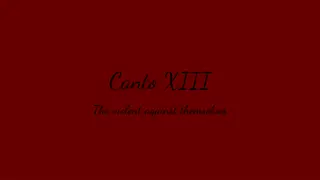Dante's Inferno Canto 17 Summary and Analysis
Located in the seventh circle of hell, Canto 17 marks the journey's last leg through the sins of violence before descending into the circles reserved for the worst sinners. Dante and Virgil encounter Geryon, a monstrous beast symbolizing fraud. The sinners, usurers, endure eternal torment by sitting on burning sand under a rain of fire, fixated on the purses around their necks, representing their greed in life. After witnessing the punishment, Dante rides on Geryon to descend further into hell. The canto explores themes of greed, punishment, and the deceptive nature of fraud.
Download Presentation

Please find below an Image/Link to download the presentation.
The content on the website is provided AS IS for your information and personal use only. It may not be sold, licensed, or shared on other websites without obtaining consent from the author.If you encounter any issues during the download, it is possible that the publisher has removed the file from their server.
You are allowed to download the files provided on this website for personal or commercial use, subject to the condition that they are used lawfully. All files are the property of their respective owners.
The content on the website is provided AS IS for your information and personal use only. It may not be sold, licensed, or shared on other websites without obtaining consent from the author.
E N D
Presentation Transcript
Location This is the last canto that takes place the seventh circle of hell, the last part of hell before descending to where the fraudulent are tortured for eternity. On the edge of a great cliff, the burning plain that takes up most of the seventh circle of hell, extends all the way to edge, where most of the canto takes place. This is the last leg of Dante and Virgil s journey through the sins of violence before descending into the last two circles, reserved for the worst of the worst.
Summary and Punishment When Virgil and Dante arrive, Geryon, the great monster of Greek myth with the face of a man, the body of a lion, and the wings and tail of a dragon, greets them, and while Virgil arranges with Geryon for safe passage to the lower levels of hell, Dante wanders to observe the punishment of the sinners in this level. Here, the usurers are tortured for eternity. They sit on the burning sand, enduring the constant rain of fire, constantly bowing their heads to a purse that is around their necks, symbolic of their over-attention to making a profit in life. The purse is emblazed with their family crest, and Dante recognizes several prominent Florentine families in their ranks. I examined several faces there among that sooty throng, and I saw none I knew; but I observed that from each neck there hung an enormous purse, each marked with its own beast and its own colors like a coat of arms. On these their streaming eyes appeared to feast (Lines 49-54). After observing the punishment, Dante rejoins Virgil and flies down to the next level of hell of the back of Geryon, the monster of fraud.
Geryon The main image referenced in this canto is the image of Geryon, the so-called monster of fraud. Being a monstrous beast with the face of a kindly man, he is referred to by Dante as the filthy prototype of fraud (line 7), making him a fitting guardian of the entrance to the eighth circle of hell, reserved for the fraudulent. His inclusion in Dante s hell is a clear allusion to the beast of the same name from ancient Greek mythology. Geryon was a descendent of both Medusa and the Titans.
Literary Devices When riding on the back of Geryon, Dante alludes to Paethon and Icarus, two other characters from myth who died because they could not control their flight, to show his own lack of comfort flying on the back of the wild beast Geryon. Geryon himself is a metaphor for fraud. He shows a pleasant, amicable face to the outside, but behind the kindly face is a fierce and deadly beast that is exceedingly dangerous, just like how fraud succeeds by playing on human s trust and violating that trust once it s too late.
Works Cited Dor , Gustave. Arrival of Geryon. Arrival of Geryon, Institute for Advanced Technology in the Humanities, 2008, http://www.worldofdante.org/pop_up_query.php?dbid=I041 &show=more. Accessed 22 Sept. 2019. Dor , Gustave. Geryon. Geryon, Institute for Advanced Technology in the Humanities, 2008, www.worldofdante.org/pop_up_query.php?dbid=I037&show=more. Accessed 22 Sept. 2019. Icarus. Greek Mythology, 1997, www.greekmythology.com/Myths/Mortals/Icarus/icarus.html. Accessed 22 Sept. 2019. Phaethon. Greek Mythology, 1997, www.greekmythology.com/Myths/Figures/Phaethon/ phaethon.html. Accessed 22 Sept. 2019.

 undefined
undefined






















